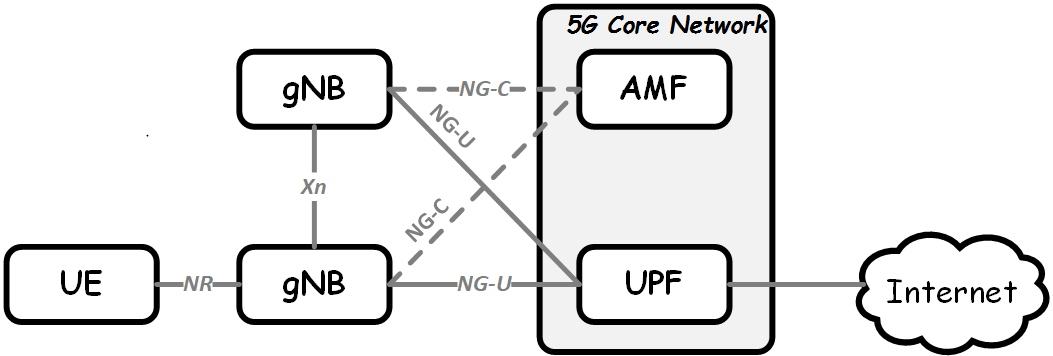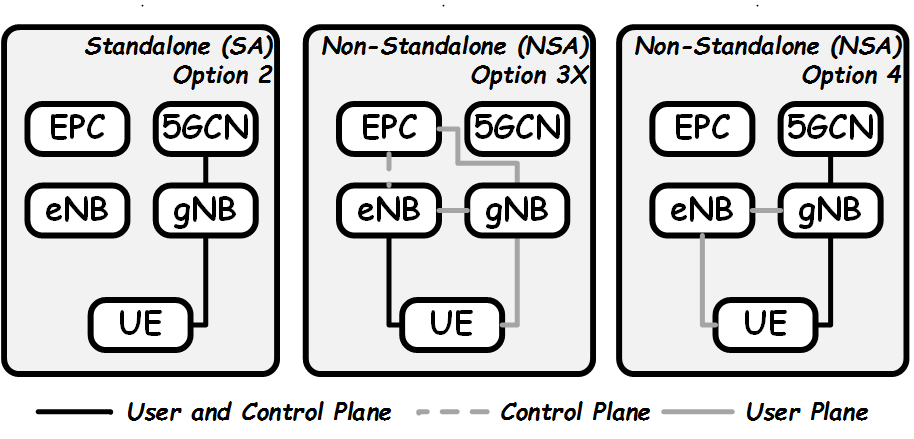5G Building Blocks Overview
5G Overview
5G is the fifth generation mobile communication that goes after LTE / LTE-Advanced (or 4G). In general, 5G term stands for a new radio network and a new core network. 5G radio interface between User Equipment (UE) and Base Station (gNB) called as New Radio (NR) while core network referred to as 5GCN. The new radio network will connect to 5GCN. At the same time 5GCN can serve LTE as well and moreover NR can be served by LTE core network (EPC) if operating in so-called Non-Standalone (NSA) mode. A picture below shows network architecture (just key nodes and its interfaces illustrated) in case of NR and 5GCN.
UPF - User Plane Function, it's a gateway between RAN and the Internet. This node handles data packets, routes and forwards it. AMF - Access and Mobility Management, it is responsible for signaling between UE and Core Network, authentication and security, idle mode procedures. Some further details about NR interface are described in next sections.
5G is being standardized by 3GPP (the Third-Generation Partnership Project). An initial version of 5G specifications was available in 2017 as a part of Release 15 (meanwhile 3GPP also works on LTE specification and both technologies will be developed further in parallel). After that it was updated several times as initial version had several items for further study. Comparing to LTE, 5G provides higher data rates and lower latency, can serve much more users (see more about 5G requirements) and based on all of that it can support new services. Key 5G technics and building blocks to meet new extremely high requirement are described below.
New Spectrum and Radio Interface Flexibility
Typical frequency bands used so far for mobile communications are less than 6 GHz. This range can be logically divided into two regions. Low-frequency bands cover range up to roughly 3 GHz. This frequency band plays a significant role for mobile communications as this range has very good waves propagation, provides really wide and deep coverage (especially frequency bands below 1 GHz). While it has limited capacity as usually bands are not so wide (up to 20 MHz). Medium-frequency bands include the range between 3 and 6 GHz (often these bands are referred to as cmW due to wave length). It can provide coverage (but not so wide as low-frequency while multi-antenna transmissions can improve coverage) and capacity as channel bandwidth can be really wide (e.g. up to 200 MHz). This range is one of the most popular bands to be used for initial 5G network deployments worldwide.Currently low-frequency and medium-frequency bands are heavily occupied already (not only for mobile communications) and it's not enough to meet high 5G data rates. So for 5G also high-frequency bands to be utilized, it's frequencies above 24GHz (these bands also known as mmW). This range has hotspot coverage while it has very high capacity because of channel bandwidth can be very wide (e.g. up to GHz using carrier aggregation feature). List of frequency bands defined for 5G by 3GPP can be found here.
Low-, medium- and high-frequency bands have its own specific (different propagation, coverage, channel bandwidth). To use all of them in an effective way there is built in flexibility on 5G radio interface. Such flexibility is also needed to meet various 5G requirements (like low latency, ultra reliability, energy efficiency and so on) and support new services. Partially this flexibility is based on numerology. Numerology (denoted as µ in 3GPP specifications) defines subcarrier spacing (SCS) that impacts symbol and slot duration. The higher numerology the shorter symbol and slot and the wider bandwidth. So with high numerology packet transmission on radio interface can be very short that helps to meet low latency requirements (<1 ms one way). A table below shows system parameters for different numerologies.
| Numerology (µ) | Subcarrier Spacing, kHz | Spectrum, GHz | Max Bandwidth, MHz | Symbol Duration, us | Slot Duration, ms |
|---|---|---|---|---|---|
| 0 | 15 | <6 | 50 | 66.7 | 1 |
| 1 | 30 | <6 | 100 | 33.3 | 0.5 |
| 2 | 60 | <6 ... >20 | 200 | 16.7 | 0.250 |
| 3 | 120 | >20 | 400 | 8.33 | 0.125 |
Another aspect of flexibility is duplex modes. 5G supports (just as LTE) both Frequency Division Duplex (FDD) and Time Division Duplex (TDD). Comparing to LTE, TDD mode is more dynamic in 5G. In LTE downlink to uplink ratio is configured semistatically and done on TTI (slot in 5G) basis while in 5G the split between downlink and uplink can be adjusted on the fly based on scheduler decisions. Moreover a part of slot can be allocated to downlink while the rest to uplink.
To enhance network efficiency and reduce energy consumption 5G specifications were designed in a way to avoid unnecessary transmissions of control / system information on radio. For example, in LTE there are always Cell Reference Signals (CRS) that transmitted all the time regardless whether there is user traffic to be transmitted or not. While in 5G it was fully revisited and reworked to reduce amount of reference signals transmitted when there is no user traffic.
Massive MIMO and Beamforming
Multiple Input Multiple Output (MIMO) is used to boost network performance. LTE supports MIMO from the very beginning. Massive MIMO support for LTE was added in later 3GPP releases. While 5G includes massive MIMO support in the first 3GPP release. The aim of that is to make 5G radio design fully optimized for massive MIMO usage. Massive MIMO benefits can be logically structured into the following three bullets:- Diversity increases probability of successful reception because of channels are (partially) uncorrelated for different antennas and these channels are differently impacted by fading during transmission.
- Spatial Multiplexing allows to boost capacity as in this case several layers (data streams) are transmitted simultaneously using the same frequency / time radio resources.
- Directivity (beamforming) is about forming beams via accurate adjustment of phase and amplitude per each antenna element. Beamforming improves network coverage (as signal transmitted over a narrow beam instead of the whole cell area) and spectral efficiency (as receiver gets signal with higher power). As signal is not spread over the whole cell it also minimizes interference and the same resources can be reused for multiple users within a cell.
Deployment Options and Multi-Connectivity
5G deployment options are shown on the next picture (just key of them. In fact there are more options defined in specifications).
5G can be deployed as a standalone (SA) solution with its own Core Network (5GCN). This option is referred to as Option 2. In this case all user and control plane data are transmitted via 5G radio to 5GCN. However to speed up 5G launches 5G radio network can be connected to LTE Core Network (EPC). This option called as Option 3. In case of Option 3X LTE is used to handle control data while 5G takes care about user data (user data can be transmitted to eNB as well but then it's forwarded to gNB) and both radio networks connected to EPC. In this case UE keeps two links (one to LTE and the other one to 5G) similar to Dual Connectivity case. This option especially makes sense when LTE deployed at low frequencies while 5G networks utilize high frequencies. Also there is an option when 5GCN is in use only. This option is referred to as Option 4. In this case LTE is used to boost data rates.